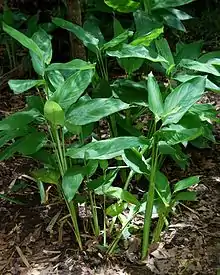葛鬱金
葛鬱金(學名:Maranta arundinacea),又稱粉薯、太白筍、竹芋、美人蕉、藕仔薯或金筍,為一多年生藥草,常見於雨林。葛鬱金所製成的澱粉常在餐飲烹飪上用於勾芡等用途。葛鬱金的使用最早可追溯至西元前8200年,於北部南美洲。
| 葛鬱金 | |
|---|---|
 | |
| 科学分类 | |
| 界: | 植物界 Plantae |
| 演化支: | 被子植物 Angiosperms |
| 演化支: | 单子叶植物 Monocots |
| 演化支: | 鸭跖草类植物 Commelinids |
| 目: | 目 Zingiberales |
| 科: | 竹芋科 Marantaceae |
| 属: | 竹芋屬 Maranta |
| 种: | 葛鬱金 M. arundinacea |
| 二名法 | |
| Maranta arundinacea L. | |
| 異名[1] | |
| |
| 每100 g(3.5 oz)食物營養值 | |
|---|---|
271 kJ(65 kcal) | |
13.39 g | |
| 膳食纖維 | 1.3 g |
0.2 g | |
4.24 g | |
| 維生素 | |
| 硫胺(維生素B1) | (12%) 0.143 mg |
| 核黃素(維生素B2) | (5%) 0.059 mg |
| 菸鹼酸(維生素B3) | (11%) 1.693 mg |
(6%) 0.292 mg | |
| 吡哆醇(維生素B6) | (20%) 0.266 mg |
| 葉酸(維生素B9) | (85%) 338 μg |
| 膳食礦物質 | |
| 鐵 | (17%) 2.22 mg |
| 鎂 | (7%) 25 mg |
| 錳 | (8%) 0.174 mg |
| 磷 | (14%) 98 mg |
| 鉀 | (10%) 454 mg |
| 鋅 | (7%) 0.63 mg |
| Link to USDA Database entry 參照美國標準的相對百分比 成人每日的参考膳食摄入量(DRI) 來源:(英文)美國農業部營養 | |
描述

葛鬱金是多年生植物,生長高度介於0.3米(1英尺)與1.5米(5英尺)之間,葉子呈矛尖形,可食用部位為其根莖,在種植後大約九十天就會開出成對的小白花。葛鬱金很少結子,一般人們透過種植發芽的部分根莖來繁殖葛鬱金。在種植大約10到12個月後,葛鬱金的根莖就可採收,而在此時植株的葉子會開始乾枯並死去。葛鬱金的根莖多肉、形狀為柱狀,且其長度介於20 cm(8英寸)至45 cm(18英寸)之間。[2]
葛鬱金很可能起源自位於巴西西北部及鄰近國家的亞馬遜雨林地區,其最適宜的生長溫度介於23 °C(73 °F)至29 °C(84 °F)之間,最適宜的降雨量則介於150 cm(59英寸)至200 cm(79英寸)之間,其處於休眠狀態的根莖可忍受低至5 °C(41 °F)的低溫。[3]
在美國本土,葛鬱金僅在佛羅里達州南部作為室外植物栽培。[4]
分佈
葛鬱金原產於墨西哥、中美洲、西印度群島(古巴、伊斯帕尼奧拉島、波多黎各、千里達、小安地列斯群島)以及南美洲(巴西、秘魯、厄瓜多爾、哥倫比亞、委內瑞拉、蘇利南、圭亞那、法屬圭亞那)。[5]在溫暖的地區廣泛種植,也被視為歸化植物:美國佛羅里達、牙買加、巴哈馬群島、百慕達、荷屬安地列斯群島、中國廣東、廣西、海南、雲南)、印度、斯里蘭卡、日本火山列島、留尼旺島、赤道幾內亞、加彭、模里西斯、柬埔寨、台灣、菲律賓、印尼等地。[6][7]
史前栽培紀錄
放射性碳定年發現葛鬱金是在史前南美地區最早被人類栽培的植物之一。在南美洲北部與巴拿馬,於公元前8200年至5600年之間,開始種植葛鬱金、中國南瓜、leren (Calathea allouia)、葫蘆等植物。[9] 有些考古學家認為葛鬱金最早並非食用而是做為藥用,用來吸出矛或箭所致傷口之毒素。[10]
Evidence of the use of arrowroot as food has been found dating from 8200 BCE at the San Isidro archaeological site in the upper Cauca River valley of Colombia near the city of Popayán. Starch grains from arrowroot were found on grinding tools. It is unclear whether the arrowroot had been gathered or grown, although the elevation of the site of 1,700(5,600英尺) is probably outside the normal range of elevations at which M. arundinacea grows in the wild. Thus, the plant may have been introduced at San Isidro from nearby lowland rain forest areas in a pioneering effort to cultivate it. Stone hoes for cultivation of plants have been found which date as old as 7700 BCE in the middle Cauca valley, 150(93英里) north of San Isidro.[11]
在早期葛鬱金可能僅限於溪流附近的小規模種植,以確保能有葛鬱金或其他根莖類植物生長時所需的濕潤。而由其纖維質的根部取出澱粉的困難,使得葛鬱金的推廣種植不易。必須先搗碎或磨碎其根部,再浸在水中以將澱粉與纖維分開。葛鬱金的澱粉易於消化。[12]
圖片集
 葛鬱金花
葛鬱金花
參考文獻
- .
- Root Crops, NRI, 1987. http://www.nzdl.org/gsdlmod?e=q-00000-00---off-0fnl2%2e2--00-0----0-10-0---0---0direct-10---4-----sti--0-1l--11-en-50---20-about-root+crops+--00-0-1-00-0--4----0-0-11-10-0utfZz-8-00&a=d&c=fnl2.2&srp=0&srn=0&cl=search&d=HASHd8d905db1c6eae0daee48f.22 页面存档备份,存于; FAO, "Maranta arundinacea", http://ecocrop.fao.org/ecocrop/srv/en/cropView?id=2335 页面存档备份,存于, accessed 19 Feb 2016
- "Maranta arundinacea", http://tropical.theferns.info/viewtropical.php?id=Maranta+arundinacea 页面存档备份,存于, accessed 19 Feb 2016
- "Arrowroot -- "Moscata arundinecea" EDIS, University of Florida, https://edis.ifas.ufl.edu/mv009, accessed 19 Feb 2016
- Kew World Checklist of Selected Plant Families, Maranta arundinacea
- Flora of China v 24, p 382, Maranta arundinacea
- "Root Crops"
- Piperno, Dolores R. (Oct 2011), "The Origins of Plant Cultivation and Domestication in the New World Tropics", Current Anthropology, Vol 52, No. 54, p. S 459. Downloaded from JSTOR.
- Piperno, Dolores R. and Pearsall, Deborah M. (1998), The Origins of Agriculture in the Lowland Neotropics, San Diego: Academic Press, p. 115, 199
- Piperno and Pearsall, pp. 199-203
- Piperno and Pearsall, pp 115, 202
- Heuzé V., Tran G., 2017. Arrowroot (Maranta arundinacea). Feedipedia, a programme by INRA, CIRAD, AFZ and FAO. https://www.feedipedia.org/node/545 Last updated on July 17, 2017, 14:10
